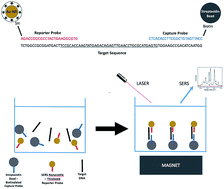Squamous cell carcinoma DNA detection using ultrabright SERS nanorattles and magnetic beads for head and neck cancer molecular diagnostics†
Abstract
A rise in head and neck cancers in low and middle countries over recent years has prompted the need for low-cost, resource-efficient diagnostic technologies. Standard diagnosis with histopathology is often not feasible due to the low number of trained pathologists in these regions, resulting in delayed diagnosis and treatment. This study presents an alternative diagnostic method to standard histopathology. We developed a surface enhanced Raman scattering (SERS) based method to distinguish squamous cell carcinoma from other cell lines. Using a “sandwich” method employing ultrabright SERS nanorattles and magnetic beads, we directly targeted specific nucleic acid markers of squamous cells. Our method was able to detect the presence of squamous cells with high sensitivity and specificity, supporting its potential for use as a diagnostic tool in head and neck fine needle aspirations (FNA).



 Please wait while we load your content...
Please wait while we load your content...